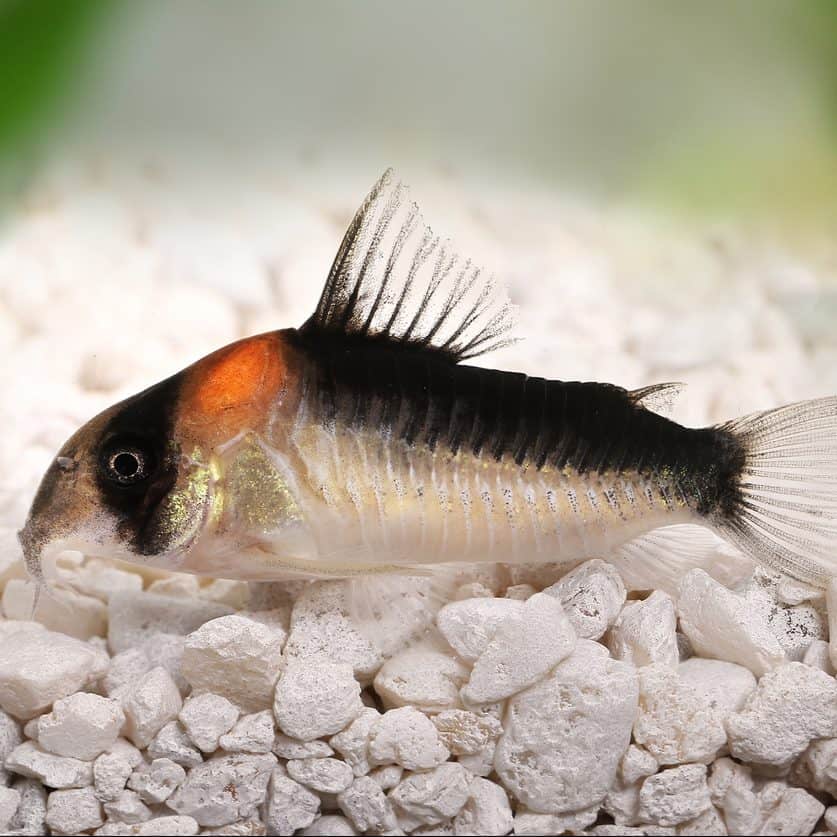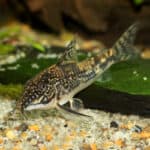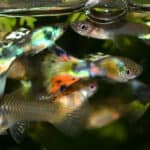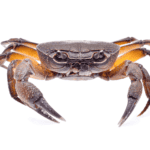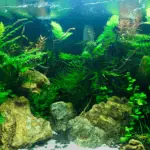The Cory Catfish is one of the most popular types of freshwater aquarium fish, but did you know there isn’t just one type of Cory Cat? There are actually at least 165 different Cory Catfish types in existence today.
That’s a lot of catfish! And with so much variety out there, how can you possibly choose which type of Cory Catfish to keep in your fish tank? That’s the question we’re going to answer in this article.
Below, you’ll find a comprehensive guide to different types of Cory Catfish. We begin with the most popular Cory Catfish types, with pictures and a description of the distinguishing features of each species, and we explain the key things you need to know to care for different types of Cory Catfish properly.
Next, we look at small types of Cory Catfish, which are great for smaller fish tanks. And finally, we answer the question of whether different types of Cory Catfish will school together, and find out whether different types of Cory Catfish generally get along with each other.
Ready? Let’s get started…
Common Cory Catfish types & what makes them special
The following 6 Cory Catfish types are among the most popular of all Corydoras species and are commonly sold in pet stores and found in aquariums all over the world.
Below, you’ll find a picture of each type of Cory Catfish along with the unique attributes that make that species different from other Corydoras.
We haven’t given specific care advice for each, as the different types of Cory Catfish all have very similar needs. For general information on how to care for all species of Cory Catfish, check out our Cory Catfish Care Guide.
Bronze Corydoras (Corydoras aeneus)
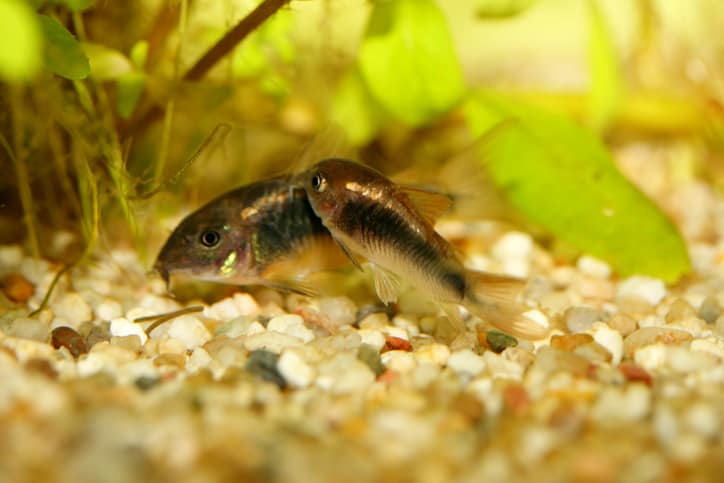
Photo credit: iStock.com/hadot
Bronze Corydoras are also known as Green Corydoras and are probably the most commonly available Cory Catfish in the pet trade today. As they are so popular, Bronze Corydoras are usually easy to find and cheap to buy.
As well as being popular and inexpensive, another reason to choose Bronze Cory Catfish is if you are interested in breeding your fish. Breeding any type of Corydoras is quite straightforward, but Bronze Cory Catfish are often reported to reproduce particularly easily.
One word of caution: Over the years, breeders have selectively bred the Bronze Cory and other types to produce a pale pink ‘albino’ variety. These albino fish may not breed as easily as the non-albino varieties. Also, you should never purchase an albino fish that has been dyed or ‘painted’. This is a cruel, harmful, and entirely unnecessary practice that involves injecting the fish with a dye.
Peppered Corydoras (Corydoras paleatus)
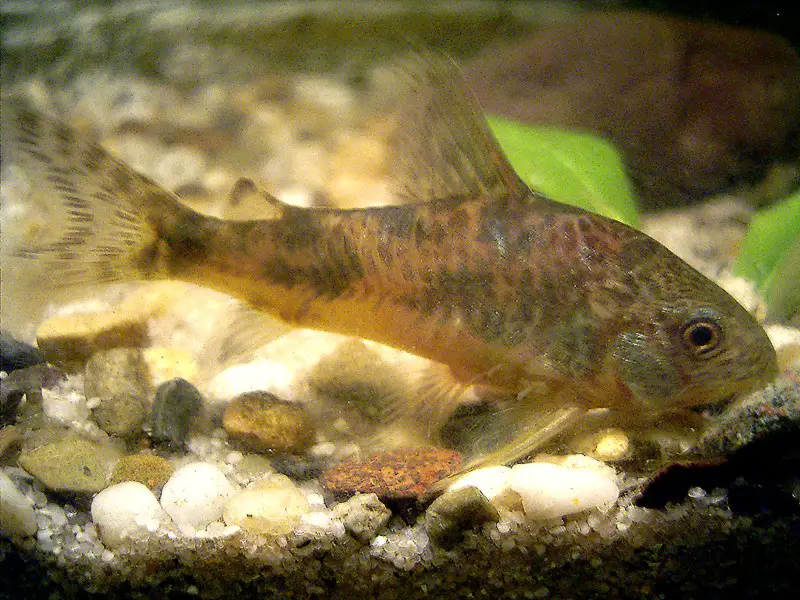
Photo credit: NiKo at German Wikipedia, Public domain, via Wikimedia Commons
Peppered Cory Catfish are very similar to their Bronze Cory cousins. Like most species of Cory Catfish, they are generally considered to be quite hardy and therefore a nice easy fish for beginners.
Sterba’s Corydoras (Corydoras sterbai)
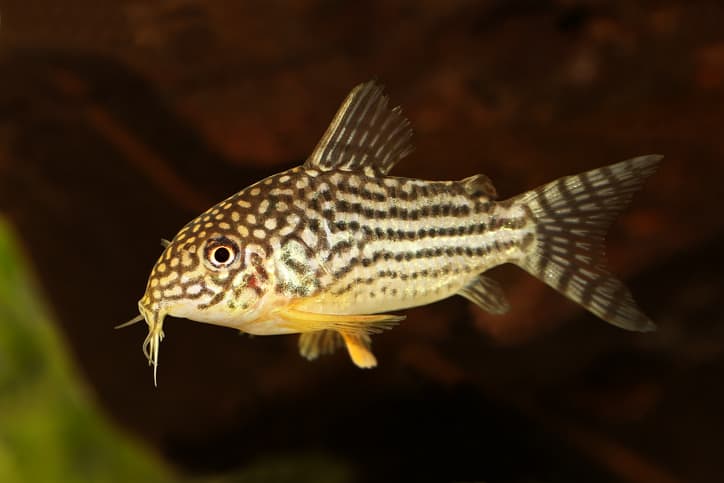
Photo credit: iStock.com/Mirko_Rosenau
There are two attributes of Sterba’s Corydoras (also known as Sterbai Corydoras) that make them a particularly appealing choice for some fish-keepers. These are their striking markings and their tolerance to higher water temperatures.
Sterba’s Corydoras can tolerate temperatures of up to 82°F (28°C) – this makes them a great choice if you have other fish that like these warmer temperatures and want to keep them all together in the same tank.
Panda Corydoras (Corydoras panda)
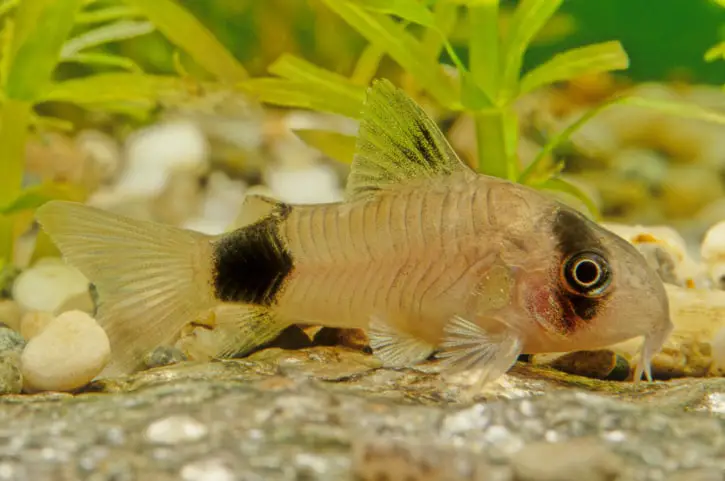
Photo credit: iStock.com/Miropa
Panda Corydoras is another highly popular variety of Cory Catfish due to their cute panda eye markings.
The most important thing to note if you are considering choosing Panda Cories is that they are often found to be less hardy than other Cory Catfish types, which makes them harder to look after. For this reason, the Panda Cory may be a better choice for more experienced Corydoras owners and beginners might want to start elsewhere.
Bandit Corydoras (Corydoras metae)
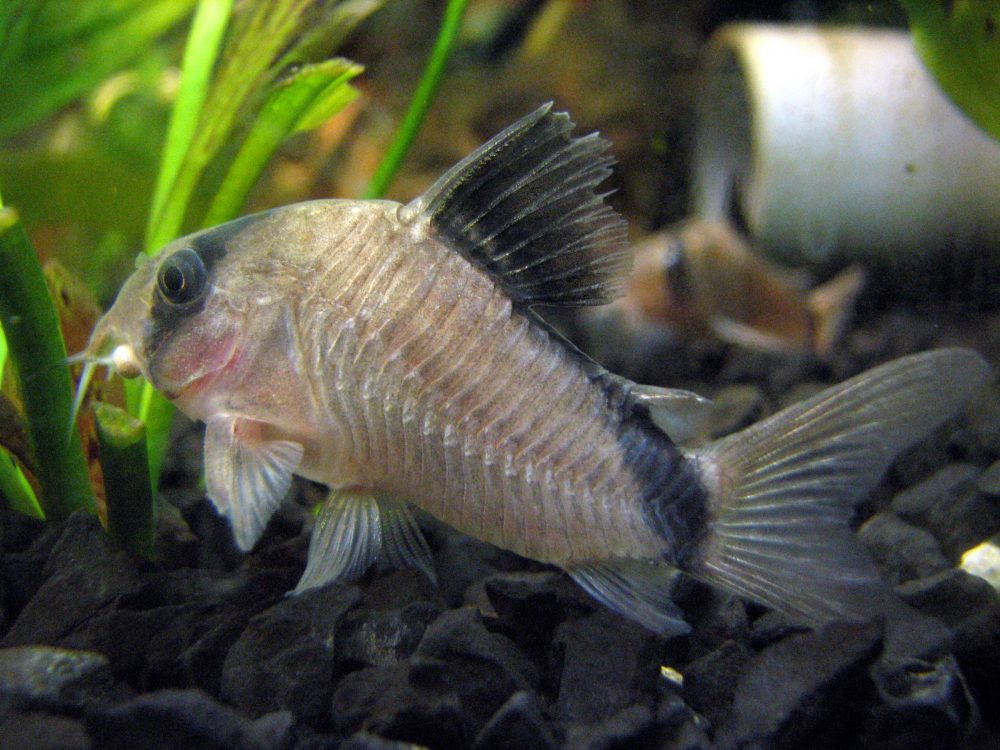
Photo Credit: Gonzalo Valenzuela, CC BY-SA 2.0, via Wikimedia Commons
Bandit Corydoras are really quite similar to the Panda Cory.
We find that the best way to tell them apart is by looking for the black streak that runs from the base of their tail and up their spine, as this isn’t present on their Panda Cory cousins.
Julii Corydoras (Corydoras julii)

Photo credit: iStock.com/slowmotiongli
Like Sterba’s Cory, which also has beautiful markings, Julii Cory Catfish are particularly desirable for their appearance. However, Julii Corydoras are generally much more difficult to find in pet stores, as they are far less widely stocked.
Interestingly, many Cory Catfish owners think they have a Julii Cory when they actually have a Three Stripe Cory (Corydoras Trillineatus). Because of their similar appearance, many pet stores incorrectly label Three Stripe Cories as the Julii variety.
Fortunately, unless you’re particularly determined to own a Julii, this common error doesn’t really matter. Both fish look very similar and require the same care.
Small types of Cory Catfish
Not everyone can afford a huge aquarium or has enough space in their house for a giant fish tank. Some people might only have room for a 20-gallon or even just a 10-gallon tank. But that doesn’t mean you can’t keep Corydoras! It just means you have to select small types of Cory Catfish that can thrive in a smaller fish tank.
These are the three smallest types of Cory Catfish.
Pygmy Corydoras (C. pygmaeus)
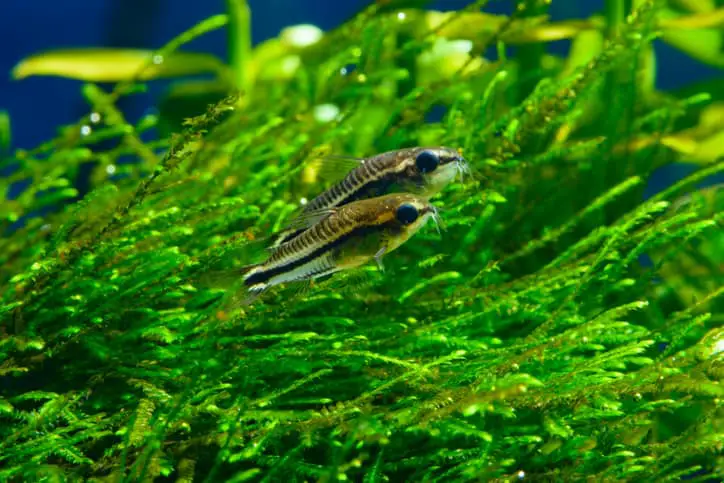
Photo credit: iStock.com/nektofadeev
Pygmy Corydoras can grow to a maximum of 1.2 inches, but most individuals stay even smaller. In most cases, male Pygmy Corydoras measure around 0.75 inches when fully grown, while females rarely measure longer than 1 inch.
Salt & Pepper Corydoras (Corydoras habrosus): Maximum 1.4 inches / 3.5 cm
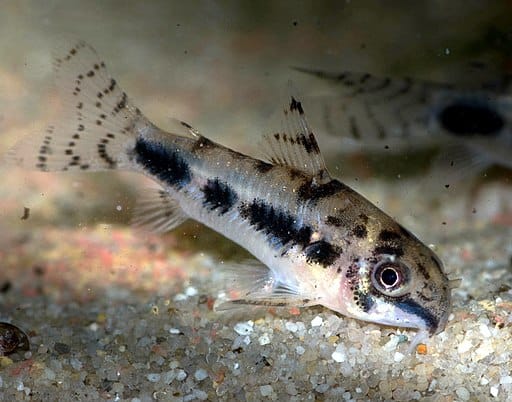
Photo credit: D.W., CC0, via Wikimedia Commons
Salt & Pepper Cory Catfish can grow to be very slightly larger than Pygmy Corydoras, but they’re still tiny. Females are larger than males and measure 1.4 inches at most.
Dwarf Corydoras (Corydoras hastatus)
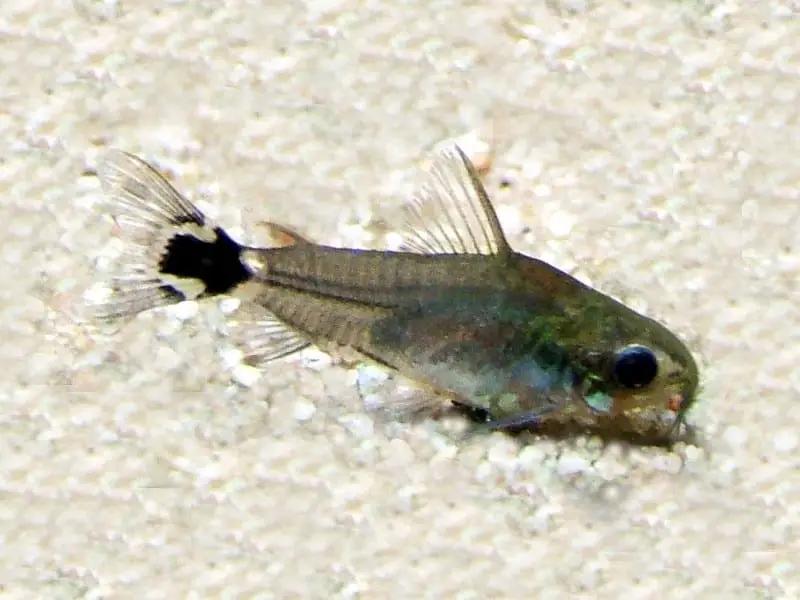
Photo credit: AquariaNR, CC BY-SA 3.0 DE, via Wikimedia Commons
Like the Salt & Pepper Cory, female Dwarf Corydoras is the larger of the sexes and have the potential to grow to 1.4 inches. However, most don’t reach this size.
Like Pygmy Corydoras, Dwarf Cory Catfish generally measure 1 inch or less.
Cory Catfish Species List: All 165 types of Cory Catfish listed
Below is a complete list of all Cory Catfish types that we are aware of. For more information on each of the species in this list, we highly recommend checking out fishbase.se. It’s a fantastic resource, not just for Corydoras, but for all kinds of fish.
| acrensis | evelynae | orphnopterus |
| acutus | eversi | ortegai |
| adolfoi | filamentosus | osteocarus |
| aeneus | flaveolus | ourastigma |
| agassizii | fowleri | oxyrhynchus |
| albolineatus | garbei | paleatus |
| amandajanea | geoffroy | panda |
| amapaensis | geryi | pantanalensis |
| ambiacus | gladysae | paragua |
| amphibelus | gomezi | parallelus |
| apiaka | gossei | pastazensis |
| approuaguensis | gracilis | paucerna |
| araguaiaensis | griseus | petracinii |
| arcuatus | gryphus | pinheiroi |
| areio | guapore | polystictus |
| armatus | guianensis | potaroensis |
| atropersonatus | habrosus | pulcher |
| aurofrenatus | haraldschultzi | punctatus |
| axelrodi | hastatus | pygmaeus |
| baderi | heteromorphus | rabauti |
| benattii | imitator | reticulatus |
| bicolor | incolicana | reynoldsi |
| bifasciatus | isbrueckeri | robineae |
| bilineatus | julii | robustus |
| blochi | kanei | sanchesi |
| boehlkei | knaacki | saramaccensis |
| boesemani | lacerdai | sarareensis |
| bondi | lacrimostigmata | schwartzi |
| breei | lamberti | semiaquilus |
| brevirostris | latus | septentrionalis |
| britskii | leopardus | serratus |
| burgessi | leucomelas | seussi |
| carlae | longipinnis | similis |
| caudimaculatus | loretoensis | simulatus |
| cervinus | loxozonus | sipaliwini |
| cochui | lymnades | sodalis |
| concolor | maculifer | solox |
| condiscipulus | mamore | spectabilis |
| copei | melanistius | spilurus |
| coppenamensis | melanotaenia | splendens |
| coriatae | melini | steindachneri |
| crimmeni | metae | stenocephalus |
| cruziensis | micracanthus | sterbai |
| crypticus | microcephalus | surinamensis |
| davidsandsi | multimaculatus | sychri |
| delphax | multiradiatus | treitlii |
| difluviatilis | nanus | trilineatus |
| diphyes | napoensis | tukano |
| duplicareus | narcissus | undulatus |
| ehrhardti | nattereri | urucu |
| elegans | negro | virginiae |
| ellisae | nijsseni | vittatus |
| ephippifer | noelkempffi | weitzmani |
| eques | oiapoquensis | xinguensis |
| esperanzae | ornatus | zygatus |
Will different types of Cory Catfish school together?
You probably already know that Cory Catfish are a schooling fish, but you may be less sure about whether different Cory Catfish types will school together. The answer is that different types of Cory Catfish will sometimes school together, but it’s not guaranteed. To guarantee schooling, and ensure the best conditions for your fish, we recommend keeping groups of the same species wherever possible.
While different types of Cory Catfish will school together in some cases, there are also situations where different species won’t form a group or socialize, and will instead keep themselves to themselves. This can lead to group sizes that are too small – or even individuals left alone – which can be very stressful for fish that instinctively want to school with others of their kind.
Will Cory Catfish of different types get along?
Do different types of Cory Catfish get along or will having different types of Cory Catfish together in a fish tank be a problem? It’s an important question, as every fish-keeper should always be aware of the dangers of putting incompatible fish into the same tank.
Fortunately, all Cory Catfish types are very peaceful and you shouldn’t have any issues with different types not getting along.
Different species of Cory Catfish also enjoy similar water parameters and tank setups – for example, similar temperatures, lots of areas to explore, and a smooth substrate. This similarity makes different Cory Catfish types easily compatible with each other given enough tank space.
Read Next…
If you’re interested in keeping any of these Cory Catfish types in your fish tank, we recommend reading our Cory Catfish Care Guide. From tank setup to feeding, general care, breeding, and avoiding diseases, it’s everything you need to know to get started with Cory Catfish, all in one place.
Featured image: Corydoras duplicareus. Photo credit iStock.com/Mirko_Rosenau.
